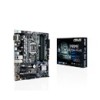Asus PRIME Z270M-PLUS PRIME Z270M-PLUS Users manual ENGLISH - Page 58
PCH-FW Configuration, Intel Platform Trust Technology, Trusted Computing
 |
View all Asus PRIME Z270M-PLUS manuals
Add to My Manuals
Save this manual to your list of manuals |
Page 58 highlights
Aggressive LPM Support [Disabled] This item is designed for LPM (link power management) support with a better energy saving conditions. When disabled, the hot plug function of SATA ports are disabled. Configuration options: [Disabled] [Enabled] SMART Self Test [On] S.M.A.R.T. (Self-Monitoring, Analysis and Reporting Technology) is a monitoring system that shows a warning message during POST (Power-on Self Test) when an error occurs in the hard disks. Configuration options: [On] [Off] SATA6G_1~4(Gray) [Enabled] Allows you to enable/disable the SATA6G_1~4 ports. Configuration options: [Disabled] [Enabled] Hot Plug [Disabled] These items allow you to enable/disable the SATA Hot Plug Support. Configuration options: [Disabled] [Enabled] M.2_2 [Enabled] Allows you to enble/disable the SATA port. Configuration options: [Disabled] [Enabled] 2.6.6 PCH-FW Configuration Intel Platform Trust Technology [Disabled] This item allows you to enable/disable Intel Platform Trust Technology. [Enabled] Enables PTT in Skumgr. [Disabled] Disables PTT in Skumgr. PTT will be disabled and all data saved on it will be lost. 2.6.7 Trusted Computing The items under this menu allow you to configure Trusted Computing settings.This menu appears only when you enable Intel Platform Trust Technology and reboot the system. Security Device Support [Enabled] This item allows you to enable/disable BIOS support for security devices such as TPM or IPTT cards. The security device is not shown on the system. TCG EFI protocol and INT1A interface are not available. Configuration options: [Disabled] [Enabled] The following items appear only when you set the Security Device Support to [Enabled]. 2-34 Chapter 2: BIOS Information















